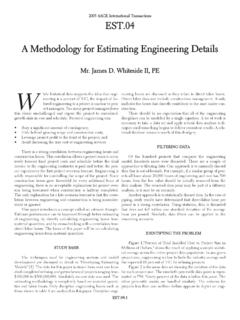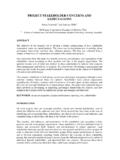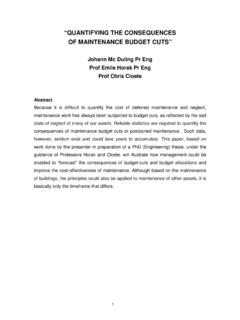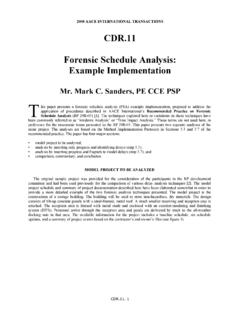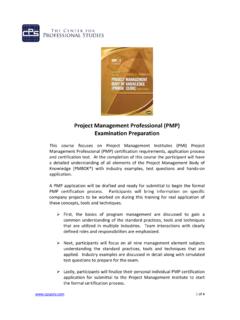Transcription of DELAY AND DELAY ANALYSIS: ISN’T IT SIMPLE?
1 DELAY and DELAY analysis Is n't It Simple ? 1st ICEC & IPMA Global Congress on project management Ljubljana, Slovenia April 26, 2006. DELAY AND DELAY analysis : ISN'T IT SIMPLE ? James G. Zack, Jr., CCM, FRICS, PMP. President Elect AACEI. Aliso Viejo, California Abstract The intended purpose of schedule DELAY analysis is to determine what happened, what was the impact on the schedule, and what was the cause ? At the outset DELAY analysis should determine what events occurred and when. From this preliminary review , DELAY analysis should then determine with some specificity, what was the outcome in terms of the schedule? That is, was th e project delayed and, if so, by how much? Finally, DELAY analysis should be used to determine who was responsible (the proximate cause) for the events whic h resulted in the project DELAY .
2 From this analysis , legal and contractual conclusions can be reached as to what type(s) of DELAY occurred and what, if any, damages are owed as a result. Simple? No! Why not? Because there is no industry-wide agreement on what a DELAY analysis consists of nor on which schedule DELAY analysis technique should be empl oyed. Does it matter? After all, scheduling is quasi-scientific . and objective ( , fact driven). All analytical techniques should render the same result, shouldn't they? This presentation discusses the status of a Recommended Practice that AACEI. has had underdevelopment for nearly two years now the Recommended Practice on Forensic Schedule analysis . This Recommended Practice defines, describes and explains the various forensic schedule analysis techniques currently employed in the construction industry.
3 The Recommended Practice neither excludes nor endorses any of the methods discussed. Rather, it classifies and discusses the known methods, offers caveats on the us e of each method and discusses best current practices and implementation of each technique. This paper summarizes portions of the Recommended Practice and provides a status update on the document. INTRODUCTION 1. At AACEI's 2002 Annual Meeting the Claims and Dispute Resolution (CDR) Committee initiated a debate over methods and pract ices of calculating lost labor productivity in construction claim situations. What the Committee rapidly determined was that (a) there are many ways to perform such a calculation; (b) various methods are often driven by the size of the dispute, the qualit y and quantity of project data available to work with, the analyst's budget and the amount of time available to perform such a task; and, (c) there is no industry wide agreement on how to perform such an analysis .
4 The Committee concluded that an acceptabl e set of standard practices should be promulgated to provide a roadmap for those involved in preparing such studies and calculations. The CDR Committee formed a task force who undertook preparation of a Recommended Practice on th e subject. Following AACE I's standard procedure concerning issuance of Recommended Practice's the task force prepared a draft document which was reviewed first by the CDR Committee as a whole and then peer reviewed by a larger group of AACEI members and other practitioners in Nort h America and Europe. Finally, the 1. Major portions of this paper have been extracted from the AACEI CDR Committee Internal Discussion Draft RP/FSA project Report, Kenji Hoshino, project Manager, December 2005, AACEI, Morgantown, WV.
5 This paper should be considered the author's interpretation of the most recent internal discussion draft. The public comment draft of the Recommended Practice Forensic Schedule analysis will be available by June 2006. Those interested in contributing to this project prior to it reaching the public comment draft stage should contact the project via its administrative contact, . 2004 2006 AACE International RP/FSA Projec t 1. DELAY and DELAY analysis Is n't It Simple ? 1st ICEC & IPMA Global Congress on project management Ljubljana, Slovenia April 26, 2006. Recommended Practice was reviewed by AACEI's Technical Board. The result of this effort was the adoption and publication of AACEI's Recommended Practice No. 25R -03, Estimating Lost Labor Productivity in Construction Claim s2 in the spring of 2004 some 21 months after the effort was started.
6 The CDR Committee at AACEI's 2004 Annual Meeting initiated a second debate, this time concerning the issue of schedule DELAY analysis -- o ften referred to by North American 3. practitioners as forensic scheduling a nalysis. Again, the Committee rapidly determined that in North America there is no agreement over the names and identities of analytical methods nor standards of practice concerning means and methods for forensic scheduling. There are numerous ways to perform such schedule DELAY analysis . Each methodology has strong points and weak points. While Courts in North America tend to prefer critical path method (CPM). analysis when dealing with issues of DELAY , they have not mandated , nor have they banned, specific practices. The Committee concluded, as they had when dealing with methods of calculating labor productivity, that forensic scheduling methods are often a function of the complexity of the dispute; the amount in controversy ; the amount of scheduling related data available to work with; and, the budget and time to perform such analysis .
7 Following on this debate, at AACEI's 2004 Annual Meeting, the CDR Committee formed a nother task force to begin the process of drafting a Re commended Practice on Forensic Scheduling analysis referred to hereinafter as the RP/FSA. The intent of AACEI's RP/FSA is to provide a unifying, standard technical reference for the forensic applicati on of schedule DELAY analysis . Forensic is defined a s belonging to, used in, or suitable to courts of judicature or to public discussion and debate . 4 Thus, forensic schedule analysis is that form of schedule DELAY analysis intended for use in DELAY claim situations in negotiation, mediation, arbitration or litigation. As a result , the RP/FSA is focuse s primarily on the Critical Path Method (CPM) of scheduling. As defined in the RP /FSA, forensic scheduling is the study and investigation of events on a project using CPM or other recognized schedule calculation methods, for potential use in a leg al proceeding.
8 F orensic schedule analysis is the study of how actual events on a project interacted in the context of a complex scheduling model for the purpose of understanding the significance of those events on the following activities within the scheduling model. The objecti ve of the RP /FSA is to set forth standard terminology and clear definitions; to define and establish minimum procedural protocols for the various accepted techniques of for ensic scheduling. Implementation of this RP /FSA should result in reduc ed disagreement amongst practitioners over technical implementation of accepted techniques and allow pro fessionals and their clients to concentrate on resolving disputes. 2. AACE International Recommended Practice No. 25R -03, Estimatin g Lost Labor Productivity in Construction Claims.
9 AACE International, Morgantown, West Virginia, , 2004. 3. In the context of this paper the term North American refers to Canadian and practices, legal precedents, etc. 4. Webster's New Collegia te Dictionary , G. & C. Merriam Company, Springfield, MA, 1979. 2004 2006 AACE International RP/FSA Projec t 2. DELAY and DELAY analysis Is n't It Simple ? 1st ICEC & IPMA Global Congress on project management Ljubljana, Slovenia April 26, 2006. PURPOSE OF FORENSIC SCH EDULING. The basic purpose and traditional uses of forensic scheduling typically include the following. Identify and Quantify Compensable DELAY Forensic scheduling analysis is generally used, initially, by a claimant 5 is seeking to prove entitlement to a time extension and time related damages such as extended field and home office overheads, equipment rental, cost escalation, etc.
10 Identify and Quantify Excusable DELAY Forensic scheduling analysis is also employed to justify entitlement to a time extension in order to avoid late completion damages under the contract. When the contract involves an early completion bonus, forensic scheduling may also be employed to show entitlement the bonus. Identify and Quantify Owner's Compensable DELAY Owners may employ forensic scheduling to determine whether late completion damages are recoverable in accordance with the contract documents. In other instances, owners may utilize forensic scheduling to defend against claims of owner -caused or compensable DELAY f rom contractors. Apportionment of DELAY Forensic schedule analysis may also play a role in analyzing a DELAY period or periods and assigning responsibility among the various parties to the contract.




